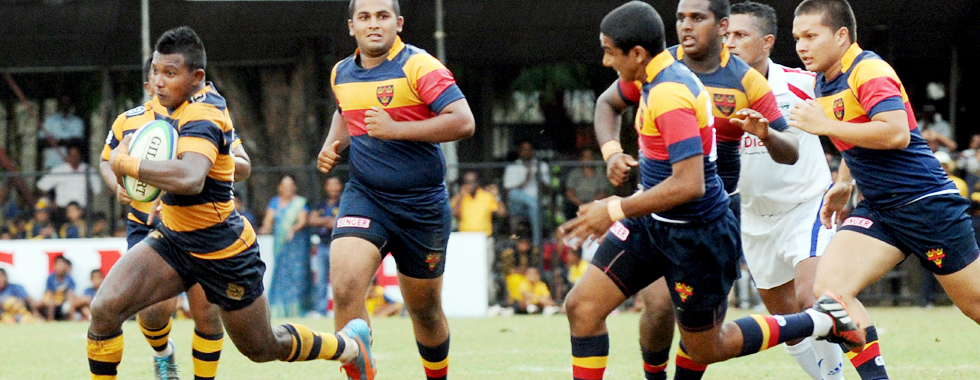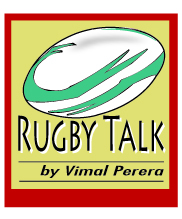Royal produced the keenest bench in years
View(s):The performance of Rugby Royal last week will be memorable to all and mostly to the players. It will be equally or more memorable to those ten players from the bench who would say, “I played in that match”. With the scoreboard reading 49 points to nil the Royalists were yelling for the fifty plus score. To coach Sanath Martis what was more important was the look on the faces of the players on the bench: it was a pleading of the eye that came into contact asking “can I be there”. Fifty plus was not what was important as the game was in the last stages. To give those boys a chance to be part of the active players was more important.
Dr. Maiya Gunasekera explaining said that opportunity was important for next year as these who were part of the winning team will boost their confidence. The rugby doctor went on to say that is where the heart of a coach should be. It is not the satisfaction of annihilating the opponent but answering the psyche of the boys who wanted to be part of the action and a future in mind.Trinity lost the game or the fight they could have given in the first 15 minutes when they made a hash of the opportunities that came their way. Royal defended stoutly ensuring the goal line was not crossed and Trinity contributed with unforced errors to weaken their ability to put points on the board. They did almost everything wrong in the rest of the game. They were unable to hold on to the ball, they were suspect with high ball, missed tackles and lost the set pieces and on top of all they could not defend the forwards attack.
Royal had a plan and they used it very effectively whether it was attacking through the forwards or the backs finishing off. With the ball in hand and more effectively forming a maul after a line out, Royal forwards only went forward. The defence to a rolling maul is never a collapse and Trinity was guilty of it a few times.
A question that is being discussed and talked of is about the temporary replacement – head injury assessment. This is a law amendment trial which has not been practiced / implemented in Sri Lanka.
The amendment trial law says, “In all situations, where there are indications of concussion the player MUST be removed from play. This is known as recognise and remove. The MUST in capitals is in the law book”.
It goes on to say ‘For tournaments and matches approved by the Union or rugby body having jurisdiction and with trained healthcare professionals, a temporary replacement may be used for a player who has a head injury and the diagnosis is not clear’.
New Zealand Rugby “Domestic Safety Law Variations” 2015 says If a referee believes a player has been concussed the referee must order that player to leave the playing area.
It goes on to say “without limiting above, in Provincial Unions that have been approved by New Zealand Rugby to take part in the Blue Card Concussion Initiative if the referee believes a player has been concussed or suspects a player has been concussed the referee must show the player a Blue Card to that player and that player will be required to leave the playing area and not return and play in the match”. This is emphasised in the Domestic Law Variations and in keeping with World Rugby Regulation 10 Medical.
The key in implementation of what is known as a concussion bin has to be read an interpreted in accordance with the law amendment trials and the protocols involved.
The key issue to me is not why a temporary replacement was not allowed. Even in much developed New Zealand Rugby it is only practiced as a Trial in selected provinces. The issue which is more important was the safety and future of the player and the ideal should have been not to send him back .World Rugby talks of a Graduated Return to Play. All the guidelines of World Rugby were put to nil as people were more interested in getting the player back on the field.
The impact on the player returning and taking part in the game can and may have more serious after effects as I saw the player whining in pain lying flat on the ground outside the dressing room after the match.
That is the bigger picture to this issue than asking why the referee did not permit a concussion bin which has not been so far approved as stated in the law amendment Trial. The Union in this instance is correct as this requires a protocol and a system and is practiced restrictively even in New Zealand Rugby. The caveat here is then for the referee to take a decision and say suspected head injury and do a simple test as given in the medical guidelines or ask the doctor if there is one and say you cannot come back. In this case there was a Doctor. What has to be understood is that in Sri Lanka, rugby is spread and cannot apply to all corners of playing fields which may have limited medical resources.
The law also says “Persons carrying water for the players may only enter the playing area during a stoppage in play due to an injury to a player.” Considering the climate this too is not practiced at present.
* Vimal Perera is a former
player, coach, referee and an IRB
Accredited Referees’ Educator


